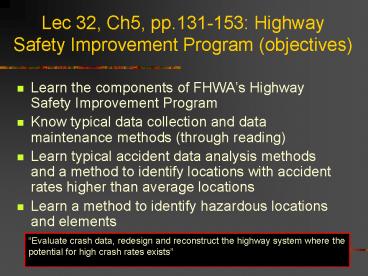Lec 32, Ch5, pp'131153: Highway Safety Improvement Program objectives PowerPoint PPT Presentation
1 / 19
Title: Lec 32, Ch5, pp'131153: Highway Safety Improvement Program objectives
1
Lec 32, Ch5, pp.131-153 Highway Safety
Improvement Program (objectives)
- Learn the components of FHWAs Highway Safety
Improvement Program - Know typical data collection and data maintenance
methods (through reading) - Learn typical accident data analysis methods and
a method to identify locations with accident
rates higher than average locations - Learn a method to identify hazardous locations
and elements
Evaluate crash data, redesign and reconstruct
the highway system where the potential for high
crash rates exists
2
What we discuss in class today (emphasis on
yellow-color topics)
- Current accident statistics
- Components of HSIP by FHWA
- Accident rates typically used
- Methods of summarizing accident data
- A method to identify high-accident-rate
locations expected value analysis - A method to identify hazardous locations and
elements
3
Wrong jump!
POW!
4
(No Transcript)
5
(No Transcript)
6
(No Transcript)
7
(No Transcript)
8
(No Transcript)
9
Almost 29 of the fatal accidents involved
speeding in 2000 (about 12,350 lost their lives).
10
Component of the Highway Safety Improvement
Program (HSIP) by FHWA
Need estimates of the effectiveness of safety
design features
11
Accident data collection and record systems
- One of the most basic functions of traffic
engineering is keeping track of the physical
inventory.
Collision diagram
Accident spot map
Example AIMS (Accident Info Mgmt System) by JMW
Engineering
12
Types of statistical displays
The purpose of the display dictates the type of
display temporal, spatial, accident type, etc.
13
Methods of summarizing accident data
- Types of accidents
- Numbers of accidents
- Time period
Occurrence
- Categories of vehicles
- Categories of drivers
- Environmental conditions
- No. of deaths
- No. of injuries
- No. of POD
Types of statistics
Severity
Involvement
14
Typical accident rates used
Bases are needed to compare the occurrence of
accidents at different sites.
- Population based
- Area population
- No. of registered vehicles
- No. of licensed drivers
- Highway mileage
- Exposure based
- VMT
- VHT
Severity index No. of deaths/accident
- Typical basic accident rates
- general accident rates describing total accident
occurrence - fatality rates describing accident severity
- involvement rates describing the types of
vehicles and drivers involved in accidents
15
Sample accident rates in pages 139-140 (rates are
usually annual values)
Rate per million of entering vehicles (for
intersections)
Rate per 100 million vehicle miles (for highway
segments)
(Thousands)
(See Example 5-1 and 5-2)
16
Determining high/low-accident locations Expected
value analysis (p.140)
- Note this method is used only to compare sites
with similar characteristics.
H0 Accident rate at the location under
consideration in the group is equal to the
average rate of the group. H1 Accident rate at
the location under consideration in the group is
not equal to the average rate of the group (In
another words, we are trying to find whether the
site under study is unusual or not. We are not
specifically proving it is over-represented or
not.)
z 1.96 for the 95 confidence level
Locations with a higher accident rate than this
value would normally be selected for specific
study.
Not over-represented or under-represented
Over-represented
Under-represented
17
Example 5-3 (modified) An intersection with 14
rear-end, 10 LT, and 2 right-angle collisions for
3 consecutive years (p.141)
- Check about rear-end collisions
Rear-end collisions are over-represented at the
study site at 95 confidence level, since 14 gt
10.34.
- Check about LT collisions
LT collisions are not over-represented or
under-represented at the study site at 95
confidence level, since 0.88lt10 lt 12.92.
- Check about right-angle collisions
Right-angle collisions are under-represented at
the study site at 95 confidence level, since 2 lt
2.4.
18
Identifying hazardous locations and elements
- Crashes happen randomly and are rare events.
You cannot identify hazardous locations simply on
the basis of the number of crashes. - A technique known as the critical crash rate
factor method is one method used to identify
hazardous locations. This method incorporates the
traffic volume to determine if the crash rate at
a particular location is significantly higher
than the average for the type of facility. - We compute first the statewide CR value for
similar types of roadway, which works as a
threshold.
CR critical crash rate, per 100 million VMT or
per million entering vehicles AVR average crash
rate for the facility type (in terms of PDO
crashes a multiplicative factor is used to
convert the impact of death/injury accidents to
PDO accidents) TF test factor, Z score
(remember this needs to be a one-way analysis
because we try to find a significantly higher
or hazardous location) for a given confidence
level, TB traffic base, 100 million VMT or
million entering vehicles
19
Identifying hazardous locations and elements
(cont)
- Once the critical crash rate is computed,
compute segment crash history in terms of PDO
equivalents. - Then compute Crash Ratio as defined below
Segment crash history
Crash Ratio
Statewide crash history
- If the resulting accident ratio is greater than
1.0, then a safety problem is likely to exist.
(Review Example 5-4)

